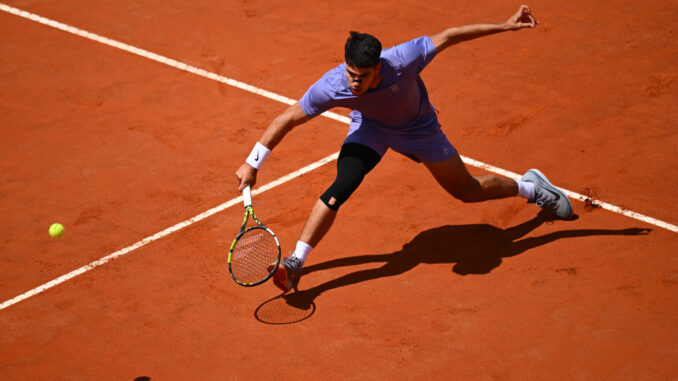
Carlos Alcaraz, the 21-year-old Spanish tennis phenom, has redefined the art of the drop shot, turning it into a weapon that leaves opponents scrambling and fans in awe. During a press conference at the 2025 Italian Open in Rome, the world number three and defending French Open champion offered aspiring players a golden nugget of advice on executing his signature shot. “The most important thing is to have a good forehand,” Alcaraz declared, emphasizing the foundation of his devastating drop shot. His words, delivered with the confidence of a player who has mastered the tactic, provide a blueprint for those looking to emulate the finesse and audacity that have made him the “drop shot king” of modern tennis.
Alcaraz’s drop shot, particularly his forehand variety, is a marvel of precision and deception. Unlike most players, who rely on backhand drop shots for easier disguise, Alcaraz employs his forehand drop shot 2.83 times per match, achieving a remarkable 67.7% win rate. On clay, where the slower surface amplifies his creativity, this figure rises to 3.81 attempts per match. His ability to wrong-foot opponents stems from a combination of explosive groundstrokes and subtle technique. By pushing rivals deep behind the baseline with heavy topspin forehands—averaging 134 km/h—he creates the perfect setup for a delicately placed drop shot that lands just over the net. “You have to see that the opponent is going back,” Alcaraz explained. “That’s the key to doing that when you are in attack mode.” This tactical awareness, honed through countless hours of practice, allows him to exploit the lag time as opponents retreat, often leaving them stranded 14.5 meters from the net.
The Spaniard’s recent performance in Rome, where he advanced to the third round with a 6-2, 6-4 victory over American Christopher Eubanks, showcased his drop shot prowess. Facing Eubanks’ powerful serve, Alcaraz mixed blistering rallies with deft touch, deploying three forehand drop shots to clinch crucial points. His ability to disguise the shot, using an imperceptible grip change and a racket motion that mimics a full-power stroke, caught Eubanks off guard. “I felt like the last month I couldn’t hit good drops,” Alcaraz admitted, referencing a dip in form during the North American hard-court swing. “My style, my game is about playing these kind of shots … so I tried to do it today.” The result was a masterclass in point construction, with 28 winners, including a backhand down-the-line drop shot that drew gasps from the Foro Italico crowd.
Alcaraz’s drop shot isn’t just a point-ender; it’s a psychological weapon. By forcing opponents to second-guess their positioning, he creates uncertainty that disrupts their rhythm. Data highlights his edge: Alcaraz wins 44% of points following a drop shot, compared to the tour average of 38.3%. His frequent use—5.4% of points, second only to Alexander Bublik—sets him apart, but it’s the 62.1% success rate that cements his dominance. Unlike Bublik, whose high-frequency drops sacrifice points, Alcaraz strikes from offensive positions, often after pushing opponents out of court. “It’s a great weapon for everyone,” he noted, encouraging players to incorporate the shot while warning, “I’m trying to hit a better shot” when facing drop shots himself.
Beyond technique, Alcaraz’s playful approach fuels his creativity. Raised at the Real Sociedad Club de Campo in Murcia, he honed his craft in unstructured, fun-filled sessions, trading drop shots with childhood rivals. This “street tennis” mentality, as his former coach José Perlas described, allows him to experiment fearlessly, even on high-stakes points like break points, where his forehand drop shot boasts a 71.4% win rate. His next challenge in Rome, a third-round clash with Chile’s Alejandro Tabilo, will test his versatility on clay, where he aims to reclaim the momentum that saw him conquer Roland Garros in 2024. As Alcaraz continues to inspire a generation, his advice to prioritize a strong forehand and keen court awareness offers a roadmap to mastering the drop shot—a shot that, in his hands, is both a work of art and a game-changer.
Leave a Reply